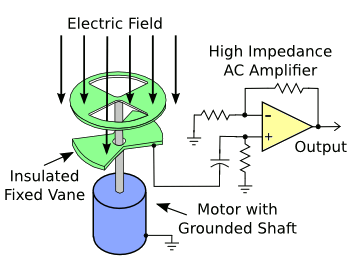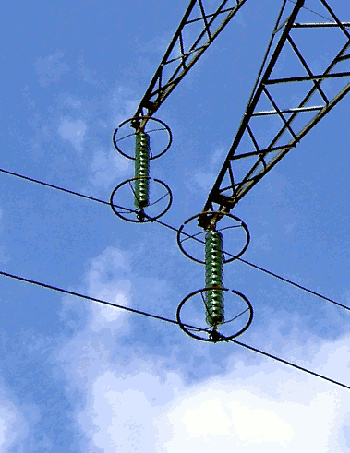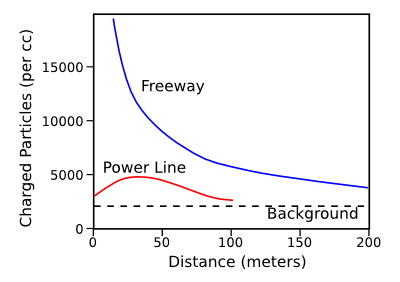Ionized Air
July 9, 2015
Biochemist and renowned
science fiction author,
Isaac Asimov, had a simple
test of whether or not someone was a
scientist. He would ask them to
pronounce the word, "unionized." Non-scientists would invariably say, "union-ized;" that is, represented by a
trade union. Scientists would say, "
un-ionized;" that is, neutrally charged.
We live in a sea of
electricity. The
friction between
molecules in the air generates static charges such that the air is
positively charged with respect to the
Earth. This results in a
atmospheric potential gradient of about a hundred
volts per
meter. This works out to nearly 200 volts from my
head to my
toes, and the only reason that I'm not perpetually in a "
bad hair day" is that the
current is low, since the number of ions is small.
As I wrote in an
earlier article (Kelvin and Atmospheric Electricity, June 19, 2013),
William Thomson, better known as Lord Kelvin, made the first accurate
measurement of the atmospheric potential gradient. Attesting to Kelvin's ability as an
experimentalist, such a measurement was extremely difficult in his age devoid of
electronic amplifiers. For his
experiment, Kelvin built a novel
water spray electrometer, and he used the primitive photography of the time as a means for data logging.[1]
Using zinc-copper cells as a voltage reference, Kelvin recorded a
voltage gradient of 137 volts/meter.[1] Since this gradient changes with atmospheric state, Kelvin thought that such measurements would help in
weather forecasting. A modern atmospheric potential gradient measuring apparatus called a field mill can be used to give warning of impending thunderstorms.[2] These are inexpensively constructed using today's
technology (see figure).

Schematic diagram of a simple field mill.
If the motor shaft is not grounded, as would be the case when it spins on a nylon bearing, a conducting brush is needed to ground the shaft.
(Illustration by the author, using Inkscape.)
As
Bob Dylan sang in
Subterranean Homesick Blues,[3] "You don't need a
weatherman to know which way the
wind blows." Likewise, your
nose can function like a field mill by detecting
ozone, ionized
oxygen, in the air ahead of a thunderstorm. Our word, ozone, derives from the
classical Greek word, οζω, to have a
smell.
Starting many
decades ago, our
society's demand for increased
electric power has been satisfied by an increased number of
electric power transmission lines. I used to pass beneath one of these on my way to
work, and there's one within a
mile of my
home. The voltage on these lines is typically about 100
kilovolts, although newer technology
high-voltage direct current lines can run to around half a
megavolt.
High voltages are used in transmission lines as a way to reduce power loss. Since power
P is the product of voltage
E and
current I,
P = EI, and loss in a
resistance R is a large function of current, only,
P = I2R, we get lower loss for the same transmitted power when the voltage is high and the current is low.
One consequence of these high voltages is a large
field gradient beneath the transmission lines. A middle-sized
transmission tower is about 100 meters high; so, with 100 kilovolts on the lines, the electric field gradient is a thousand volts per meter, or ten times the typical atmospheric value. This makes you wonder about the
safety of being under these transmission lines for a long time.
The
World Health Organization has a
website devoted to
public health affects of
electromagnetic fields.[4] Although it would not be
prudent to build a
school under a high voltage power line, for at least one reason aside from possible electric field affects, there doesn't seem to be any conclusive evidence for any
biological effect of an electric field gradient of a thousand volts per meter.[5] However, a few people complain of
symptoms of
electromagnetic hypersensitivity, sometimes so severe as being affected by low-power
Wi-Fi signals. If I had such problems, I would relocate to
Green Bank, West Virginia.
Although people are fixated on electric transmission towers, presumably because they are
megaliths of our modern age, There are other sources of large electric fields in the
environment. A thunderstorm can produce a field gradient of about 3 kV/m. Walking across a
polyester carpet on a dry
winter's day can charge your body to about 6 kV, which is enough to generate a 2
millimeter spark to a
light switch plate. The
dielectric strength of dry air is about 3 MV/m, 30 kV/cm, or 3 kV/mm.

High voltages can produce a corona, an electric discharge in the air caused by ionization.
Corona can be suppressed by corona rings, examples of which are shown on this 400 kV power line.
These rings spread the electric field over a larger volume.
(Detail of a photo by Jean-Pierre Daniel, via Wikimedia Commons.)
A team of scientists from the
International Laboratory for Air Quality and Health of the
Queensland University of Technology (Brisbane, Australia) have discovered that other common features of our modern
technological infrastructure,
highways, generate many more charged particles than electric transmission lines.[6-7]
Previous studies by this same group found that
ion concentration in
parks in a typical
urban environment had a background level of about 270 ions per
cc.[8-9] They found that power lines and
electrical substations were strong
unipolar sources of ions, while
motor vehicle exhaust was a strong
bipolar source.[8]
Positive and
negative ion concentrations near a
highways were found to be
linearly related to
traffic density, with heavy
diesel vehicles being the main source of ions near busy roads.[9]
Their current work showed that charged particle concentrations within ten meters of busy roads exceeded those under power lines by a factor of fifteen.[6] The concentration is still twice as much at forty meters distance.[6] For power lines, these ions originate from
corona ions that attach to
aerosols to form charged particles.[6] For motor vehicles, the culprits are
nanoparticles present in exhaust, and this effect is most pronounced for heavy diesel vehicles. Such vehicles have high particle and charge emissions.[6]

Charged particle concentration near power lines and roadways.
(Inkscape illustration by the author, using data from ref. 6.)[6]
Rohan Jayaratne, a
Research Fellow at QUT's International Laboratory for Air Quality and Health who participated in the study, readily states that no firm connection between power lines and health has been found, but the influence of motor vehicles hasn't been realized.
"Although the effects of ions and charged particles generated by high-voltage power lines on human health is still open to conjecture, there has been a lot of attention on increased exposure due to expanding power networks in urban residential areas... However what people do not realize is that a large number of charged particles in urban environments come from motor vehicle emissions.[7]
There is no evidence that breathing in air ions is a health risk, but half of fine particles
inhaled through normal breathing are deposited in the
lungs. Since, as Jayaratne says, "Diesel emissions contain a range of
toxic chemicals and have recently been classified as 'probably
carcinogenic to humans'," ionized particles are a problem.
"We do not believe that ions are dangerous - the danger comes from the pollutants. The ions merely assist the particles to stick to the lungs. If there are no dangerous particles in the air to attach to the ions, there is no risk of ill health."[7]
References:
- K. L. Aplin and R. G. Harrison, "Lord Kelvin's atmospheric electricity measurements," arXiv Preprint Server, May 23, 2013.
- Chapter 6, "Instrumentation And Measurements," from Lars Wåhlin, "Atmospheric Electricity," Research Studies Press, John Wiley & Sons (New York, 1989), ISBN 0-471-91202-6.
- This song is part of Dylan's Bringing It All Back Home. studio album, a vinyl copy of which I have on my record shelf.
- Electromagnetic hypersensitivity, Electromagnetic fields and public health, World Health Organization, December, 2005.
- Chapter 9: Health Risk Assessment, Static Fields, in Environmental Health Criteria Monograph No.232, World Health Organization, 2006.
- E.R. Jayaratne, X. Ling, and L. Morawska, "Comparison of charged nanoparticle concentrations near busy roads and overhead high-voltage power lines," Science of The Total Environment, vol. 526 (September 1, 2015), pp 14-18.
- Roadside air can be more charged than under a high-voltage power line, Queensland University of Technology Press Release, May 28, 2015.
- Xuan Ling, Rohan Jayaratne, and Lidia Morawska, "Air ion concentrations in various urban outdoor environments," Atmospheric Environment, vol. 44, no. 18, (June 2010), pp. 2186-2193. Available, also, at the journal web site.
- Rohan Jayaratne, Xuan Ling, and Lidia Morawska, "Ions in motor vehicle exhaust and their dispersion near busy roads," Atmospheric Environment, vol. 44, no. 30 (September 2010), pp. 3644-3650. Available, also, at the journal web site.
Permanent Link to this article
Linked Keywords: Biochemistry; Biochemist; science fiction; author; Isaac Asimov; test; scientist; pronunciation; pronounce; trade union; ionization; electric charge; neutrally charged; electricity; friction; molecule; atmosphere of Earth; air; static electricity; static charge; positively charged; Earth; atmospheric electricity; atmospheric potential gradient; volt; meter; head; toe; bad hair day; electric current; ion; William Thomson, 1st Baron Kelvin; Lord Kelvin; measurement; experimentalist; electronic amplifier; experiment; water; electrometer; photography; data logger; data logging; voltaic pile; zinc-copper cell; voltage reference; potential gradient; voltage gradient; weather forecasting; field mill; thunderstorm; technology; ground; nylon; bearing; conducting brush; Inkscape; Bob Dylan; Subterranean Homesick Blues; weather forecasting; weatherman; wind; nose; ozone; oxygen; Greek language; classical Greek; odor; smell; decade; society; electric power; electric power transmission line; job; work; mile; home; volt; kilovolt; high-voltage direct current; megavolt; resistance; field gradient; transmission tower; safety; World Health Organization; website; public health; electromagnetic field; prudence; prudent; school; biology; biological; symptom; electromagnetic hypersensitivity; Wi-Fi; Green Bank, West Virginia; megalith; environment; polyester; carpet; winter; millimeter; light switch plate; dielectric strength; corona discharge; electric discharge; corona ring; Wikimedia Commons; International Laboratory for Air Quality and Health; Queensland University of Technology (Brisbane, Australia); technology; technological; infrastructure; highway; ion; concentration; park; urban environment; cubic centimeter; cc; electrical substation; electrical polarity; unipolar; motor vehicle; exhaust gas; bipolar; positive; negative; linear function; traffic; number density; diesel engine; motor vehicle; aerosol; nanoparticle; Inkscape; Rohan Jayaratne; Research Fellow; inhalation; inhale; lung; toxicity; toxic chemical; carcinogen; carcinogenic; pollutant.